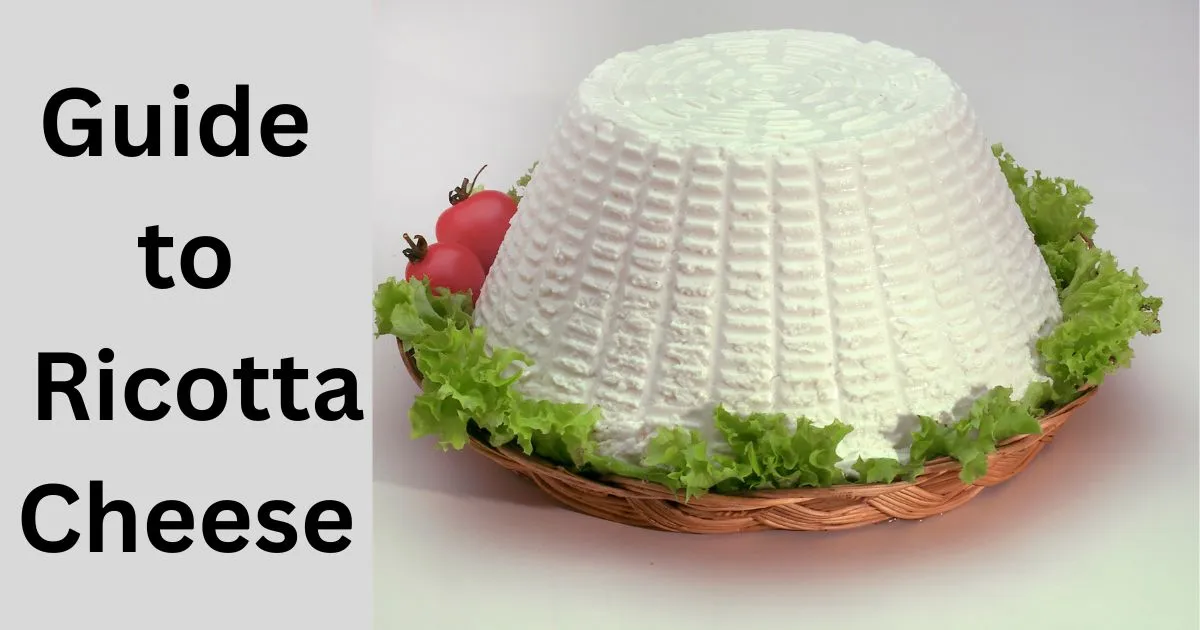Ricotta is a fresh Italian whey cheese made from sheep, cow, goat, or Italian water buffalo milk whey left over from the production of other cheeses such as Parmesan and Cheddar. but the ricotta that we consume most frequently is made from cow milk. Ricotta meaning ‘recooked’ or ‘refined’ in Italian
Top 12 Facts About Ricotta Cheese:
- Source of Milk: Cow milk (sometimes made from sheep or goat milk)
- Texture: Creamy and slightly grainy
- Colour: White
- Flavour: Mild, slightly sweet, and creamy
- Fat Content: 10-15%
- Aging Time: Not aged; usually fresh
- Pasteurized: Typically pasteurized
- Country of Origin: Italy
- Town: Produced in various Italian regions
- Named After: Italian word “ricotta,” meaning “recooked” (referring to the cheese-making process)
- Certification: No specific certification, but some varieties may be made with high-quality standards
- Uses: Ideal for lasagna, ravioli, desserts like cheesecake, and as a filling or topping in various dishes
Like other whey cheeses, it is made by coagulating the proteins that remain after the casein has been used to make cheese, notably albumin and globulin.
When cheese is made, you separate milk into two distinct things. You have the solids, called curds, which will be separated out and pressed to form cheese. And you have the liquid that is left behind, called whey.
Ricotta curds are creamy white in appearance, and slightly sweet. The fat content varies depending on the milk used.
ALSO READ: Camembert Cheese: A Comprehensive Guide
For a comprehensive overview of ricotta cheese’s origins, varieties, and traditional uses, you can visit Wikipedia’s entry on Ricotta.
this guide will provide you with everything you need to know about ricotta cheese, its history, types of ricotta cheese, uses, recipe:
History of Ricotta Cheese
Ricotta cheese has its roots in ancient Italy, where it was first produced by shepherds using leftover whey from other cheese-making processes. The name “ricotta” translates to “recooked” in Italian, reflecting its traditional method of production.
The increased production of rennet-coagulated cheese led to a large supply of sweet whey as a byproduct. Cheesemakers then started using a new recipe, which used a mixture of whey and milk to make the traditional ricotta as it is known today.
Originally a byproduct of cheese-making, ricotta became popular due to its rich texture and versatility in cooking. Today, ricotta cheese is a beloved ingredient in both traditional and modern Italian dishes.
How Ricotta Cheese is Made
The Ricotta cheese recipe is unique because it’s made from whey, the liquid remaining after milk has been curdled and strained. The process begins by heating the whey, which causes the remaining proteins to coagulate and form curds.
These curds are then strained and cooled, resulting in the soft, fluffy cheese we know as ricotta. Unlike many other cheeses, like Mozzarella and Parmesan, ricotta is not aged, giving it a fresh, mild flavour.
ALSO READ: Cream Cheese Essentials
Types of Ricotta Cheese
There are several varieties of ricotta cheese, each with its unique characteristics. Fresh ricotta can be subject to extra processing to produce variants that have a much longer shelf life. These production methods include salting, baking, smoking, and further fermentation.
1. Ricotta di Pecora:
Ricotta di Pecora is made from the whey of sheep’s milk, which has a higher fat content than cow’s milk. This results in a creamier texture and a more intense, slightly sweet flavour. The richness of sheep’s milk also imparts a subtle tanginess to the ricotta, setting it apart from other types of ricotta cheese.
2. Ricotta di Bufala:
Ricotta di Bufala, or buffalo milk ricotta, is a luxurious variety of ricotta cheese known for its exceptionally creamy texture and rich flavor. Originating from Italy, this cheese has become a favourite among gourmets and chefs for its unique qualities.
3. Ricotta Salata:
Ricotta Salata, meaning “salted ricotta” in Italian, is a pressed and aged version of the traditional ricotta cheese.
This distinctive cheese is known for its firm texture and mildly salty flavor, making it a versatile addition to various culinary dishes. Ricotta salata is sold in wheels, decorated by a delicate basket-weave pattern.
4. Ricotta Infornata:
Also known as baked ricotta, is a unique and flavorful variety of ricotta cheese that is baked to achieve a firm texture and rich, caramelized flavor. This Italian delicacy offers a delightful twist on traditional ricotta, making it a versatile ingredient in various dishes.
5. Ricotta Affumicata:
Ricotta Affumicata, or smoked ricotta, is a unique variety of ricotta cheese that brings a rich, smoky flavor to the table. Originating from Italy, this speciality cheese is beloved for its distinctive taste and versatility in culinary applications.
ALSO READ: The Ultimate Guide to Bel Paese Cheese
Uses of Ricotta Cheese
Ricotta cheese’s versatility makes it a favourite in many kitchens. Here are some popular ways to use ricotta in your cooking:
- Pasta Dishes: Ricotta is a key ingredient in many pasta dishes, such as lasagna, stuffed shells, and ravioli. Its creamy texture adds richness to these recipes.
- Desserts: Ricotta is often used in Italian desserts like cannoli, cheesecake, and ricotta pie. Its mild sweetness pairs well with fruits, honey, and chocolate.
- Breakfast: Spread ricotta on toast, pancakes, or waffles for a creamy, protein-rich breakfast. Add a drizzle of honey and some fresh berries for extra flavor.
- Appetizers: Use ricotta as a base for dips and spreads, or serve it with bread and olives for a simple yet delicious appetizer.
- Salads: Add a dollop of ricotta to salads for a creamy contrast to crisp greens and vegetables.
Easy Ricotta Cheese Recipe
If you want to experience the freshness of homemade ricotta, here’s a simple ricotta recipe to try:
Ingredients:
- 4 cups whole milk
- 1 cup heavy cream
- 1/2 teaspoon salt
- 3 tablespoons lemon juice
Instructions:
- In a large pot, combine the milk, cream, and salt. Heat over medium heat until the mixture reaches 200°F.
- Remove from heat and stir in the lemon juice. Let the mixture sit for about 10 minutes, until curds form.
- Line a colander with cheesecloth and place it over a large bowl. Pour the curds and whey into the colander.
- Let the curds drain for about 1 hour. The longer it drains, the firmer the ricotta will be.
- Transfer the ricotta to a container and refrigerate. It will keep for up to 5 days.
Also Read: The Ultimate Guide to Cheddar Cheese
To learn about the nutritional benefits of ricotta cheese, such as its high protein content and digestive properties, check out Healthline’s guide.
More on Cheese
- Exploring Parmesan or Parmigiano-Reggiano cheese
- Mozzarella cheese | Origins, Production, uses
- Homemade Ricotta Cheese Recipe
- Complete guide to Feta cheese
- Discovering The Cottage Cheese
- The Ultimate Guide to Danish Blue Cheese
- The Ultimate Guide to Bel Paese Cheese
- Cream Cheese Essentials: Everything You Need to Know
- Camembert Cheese: A Comprehensive Guide
- 27 different types of cheese: their origin and uses
- Service of cheese in restaurants
Subscribe and join our community of hospitality professionals & students — get insights, tips, and the latest updates delivered straight to your inbox!







